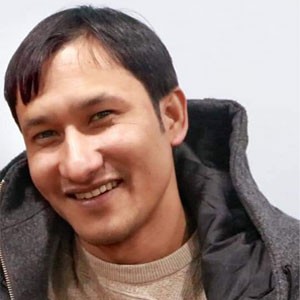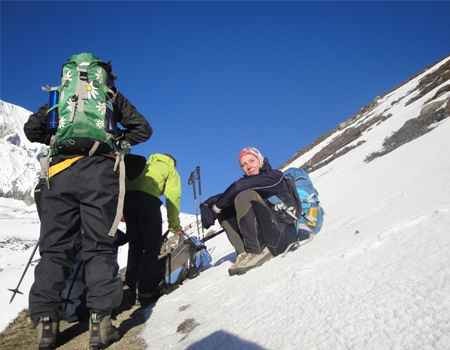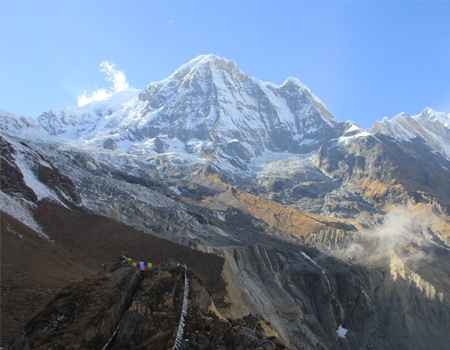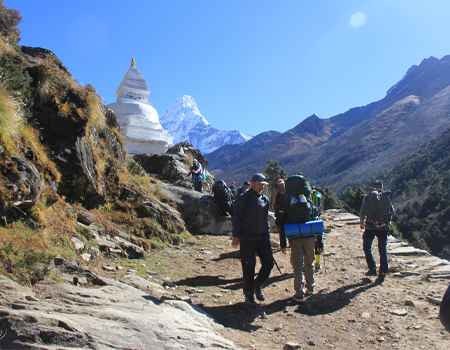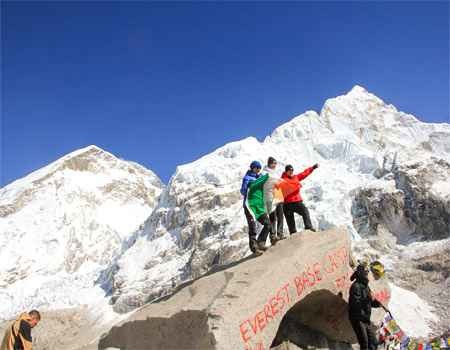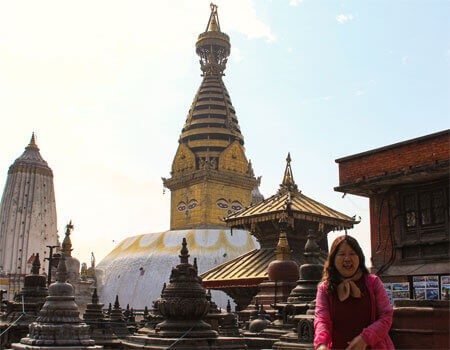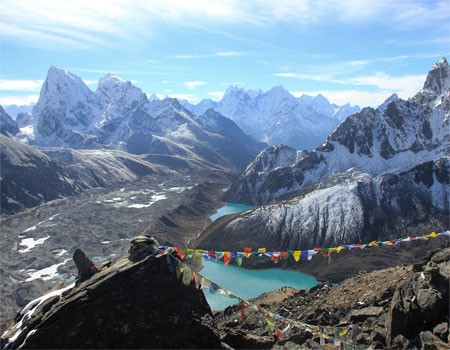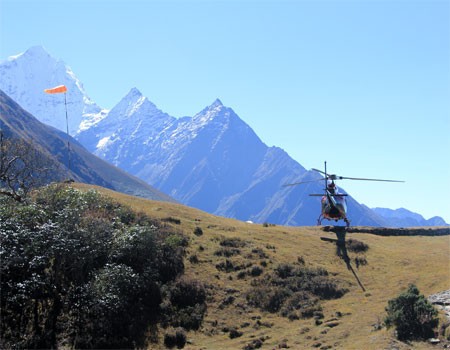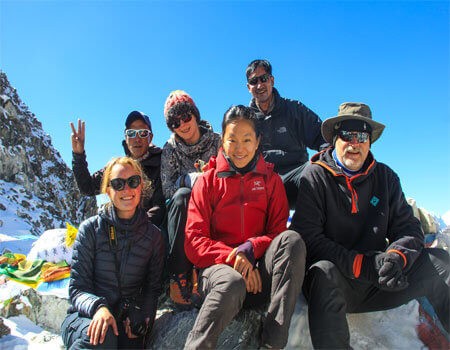In this blog post, we have tried to compare Everest Base Camp and Gokyo Lakes Treks. Both treks are located in the same region in Nepal. Please check the differences between Base Camp and Gokyo Valley for itineraries, difficulties, views, and the best times to visit.
EBC vs. Gokyo Lakes: Trekking Itinerary
Everest Base Camp Trek and Gokyo Lakes Trek begin with a short flight to Lukla after a full-day city tour in Kathmandu to adjust altitude before visiting the high mountain elevation. After landing at Lukla Airport, the Trek goes to Phakding on the first day and Namche Bazaar on the second, where you will have one altitude practice rest day in Namche on both trekking itineraries. Also, the last two days of trekking from Namche to Lukla and the flight back are the same for Everest Base Camp and Gokyo Lakes, but the trek duration among these is different. So, the Gokyo Lakes trip is shorter than the EBC.
Base Camp Trekking Itinerary
.jpg) Khumbu Valley in Base Camp Route
Khumbu Valley in Base Camp Route
The Base Camp Trekking Itinerary is a 12-day journey in the Everest region from Kathmandu to Kathmandu. It starts with a scenic flight and ends with flying out of Lukla. It has two rest days for acclimatization for the altitude practices in Namche Bazaar and Dingboche. However, you can fly from Gorakshep to Kathmandu on a helicopter if you do not have sufficient time to complete the classical trekking itinerary.
1st Day: Fly to Lukla (2840m) and Trek to Phakding (2610 m).
On the first day, you fly into Lukla from Kathmandu. Still, the flights operate from Ramechhap (Manthali) Airport during high trekking seasons to control air traffic at Kathmandu International Airport. To fly from Manthali, you drive around four hours from Kathmandu very early, around one or two a.m., and then fly on a small aircraft.
After landing at Tenzin-Hilary Airport, you stop in Lukla for breakfast and Trek to Phakding on descending trails through Chheplung, Thadokoshi, and Ghat villages. It took around three hours to reach Phakding today, and I stayed overnight there.
2nd Day: Trek to Namche Bazaar (3440m)
Walking time: 6-7 hours
On the second day, you trek from Phakding to Namche Bazaar, which is extended. It takes around 6-7 hours, gradually ascending until lunch and making steep climbs for the last two to a half hours.
Today, you cross five suspension bridges on the same river, Dudhkoshi. Today, pass some Sherpa settlements like Toktok, Bankar, Monjo, and Jorsale and see a beautiful view of Mt. Thamserku, waterfalls, and streams by following the Dudhkoshi River. You enter the Sagarmatha National Park today after Monjo, a natural UNESCO World Heritage Site in Nepal.
3rd Day: Rest in Namche and hike to Hotel Everest View (3880 m).
Acclimatization Day in Namche
You hike to the Hotel Everest View (HEV) in the morning for altitude practice, which takes around 3 hours from Namche Bazaar. The trail ascends through the town for 20 minutes to the top of Namche and then climbs to the left towards Syangboche. You see a rough airport along the way to the Everest View Hotel, Nepal's highest airport.
From here, the views are open so that you can see magnificent views of the mountains: Kusum Kangaroo, Thamserku, Khangteka, Amadablam, Peak 38, Lhotse, Nuptse, Everest, and higher snow-capped peaks. Once you reach the HEV, you can enjoy stunning views of the Himalayas, beautiful valleys, and traditional villages from its terraces with hot drinks. It is the world's highest-elevated hotel, where the Everest Base Camp Helicopter Tour travelers land for breakfast.
After seeing the beautiful scenery from the hotel, you can hike back to Namche Bazaar or visit Khumjung, where you can see the skull of a Yeti in the monastery.
4th Day: Trek to Tengboche (3860m)
Walking time: 5–6 hours
Today, you trek to Tengboche, a hill station with an ancient Buddhist monastery. It is 3860 meters above sea level and offers stunning views of the Everest Himalayas. It is the best place to see Mt. Ama Dablam.
The day begins with ascending the trail to the top of Namche Bazaar, which takes around 20 minutes. After this, you have a comfortable walk for another 2 hours to Kyanjuma. You have the same mountain view as the altitude practice walk today along the way. The trail goes downwards to Phunki-Tenga for about an hour from Sanasa, and another two hours ascend through rhododendron and pine forest to Tengboche. So, it is around 5–6 hours of walking today.
5th Day: Trek to Dingboche (4410m)
Walking time: 5 hours
Today, walking from Tengboche to Dingboche is about 5 hours. The day begins with a downhill hike through pine and rhododendron forests to Deboche; the trail goes flat for half an hour. You cross a bridge here and then start ascending towards Pangboche Village. Now, you reach above the tree line, with open mountain views every second from today. You stop in Somare for lunch and hike for two more hours to Dingboche.
6th Day: Second acclimatization day in Dingboche and hike to Nangkar-Tshang Hill (5100 m).
Acclimatization day in Dingboche
After breakfast, you hike for about four hours on a steep trail to Nangkar-Tshang Hill. Today, you see Mt. Makalu (4th highest mountain in Nepal and 5th in the world), which you cannot see from other places during the EBC trek. Imja and Pheriche Vallyes looked attractive from the top while climbing this peak. You cannot see Mt. Everest today, but many other high mountains like Ama Dablam (in a different shape), Thamserku, Khangteka, Taboche, Cholatse, Lhotse, Nuptse, and more. You can also see some beautiful small glacial lakes today. You will be acclimatized even if you do not reach the summit; however, the views from the top are far better.
7th Day: Trek to Lobuche (4910m)
Walking time: 5 hours
After being acclimatized at Nangkar-Tshang Peak, you trek to Lobuche. The day starts with a gradual ascent of around 15 minutes; the trail stays flat for another 3 hours until Thukla. You cross Khumbu Khola coming from the Khumbu Glacier before getting to Thukla.
You have a steep trail to the top of Thukla for about an hour now, and you see many memorials for dead climbers. The Thukla top is often very windy, so keep warm clothes in your daypack; otherwise, you will be chilly while visiting the memorials. From here, the trail goes flat with rocky paths until you reach Lobuche for another hour.
8th Day: Trek to Gorakshep (5180m) and Hike to EBC (536 m).
Walking time: 7-8 hours
It is an important day because you are reaching the bottom of the world's tallest and most famous mountain. You depart earlier in the morning from Lobuche than the other mornings, walk on a flat part for about an hour, and ascend for 15 minutes on Lobuche Pass.
After Lobuche Pass, you will have an easy trail for another 15 minutes and walk on a glacier with up-and-down trails and lots of stones. You see the massive Khumbu Glacier on your right while walking to Gorakshep. It takes 3 hours to reach Gorakshep from Lobuche, where you take a quick lunch and hike to Everest Base Camp for another 2-3 hours one way. After a successful EBC visit, you hike back to Gorakshep and stay overnight.
9th Day: Hike to Kalapatthar (5550m) and trek to Pangboche (3985 m).
Walking time: 8 hours
You hike Kalapatthar early in the morning with a flashlight from Gorakshep. It takes around two hours to reach the top from the lodge, where you can see stunning 360° Everest Himalayan views, including Everest, Lhotse, Nuptse, Pumori, the Tibetan mountain Changatse, and more. It is the best hill station to see the world's highest mountain from a close distance.
After visiting this vantage viewpoint, you hike back to the lodge, have breakfast, and then trek backward to Pangboche, which takes 6 hours through Lobuche, Thukla, and Pheriche.
If you do not have more days to complete the EBC trek itinerary, you can fly by helicopter directly to Kathmandu today. If this is the case, we will arrange for others to join the flight for you.
10th Day: Trek back to Namche Bazaar (3440 m).
Walking time: 6-7 hours
Today, you feel much better walking and breathing because you returned to the tree line. The day begins by descending the trail to the river with an open view for about half an hour and then entering the foresty part. You walk on the flat path inside the forest for an hour and climb to Tengboche for half an hour. You have a long, descending trail with many tiny stones on the path. You walk around an hour downhill here, and the uphill begins.
After ascending for an hour and a half, you reach Sanasa, from where the trail to Gokyo Valley divides, and stop in Kyanjuma for lunch. The final part of Namche Bazaar will be an easy walk of 2 hours and a half.
11th Day: Trek back to Lukla (2840 m).
Walking time: 8 hours
Today is your last day walking in the mountains, but it is long. You will trek to Lukla in one day instead of two days on the way up. Don't worry; the trail will be more accessible because you are already well-acclimatized from the base camp.
The day begins with descending the trail for about an hour and crossing Hilary Bridge. You cross those five suspension bridges again on the second day until Phakding and stop for lunch. The trail after Phakding gradually ascends to Lukla, where you spend the last night before flying back to Kathmandu or Ramechhap.
12th Day: Fly to Kathmandu or Ramechhap (Ramechhap).
Today, you take the morning flight from Lukla to Kathmandu or Ramechhap (Manthai Airport) with sweet memories of the Everest Himalayas. You drive about four hours to Kathmandu if you fly to Ramechhap.
You might be interested in this Trek after seeing the itinerary above. You can contact me for further information about the trip or directly book your reservation to trek to Everest Base Camp.
Gokyo Valley Trek Itinerary
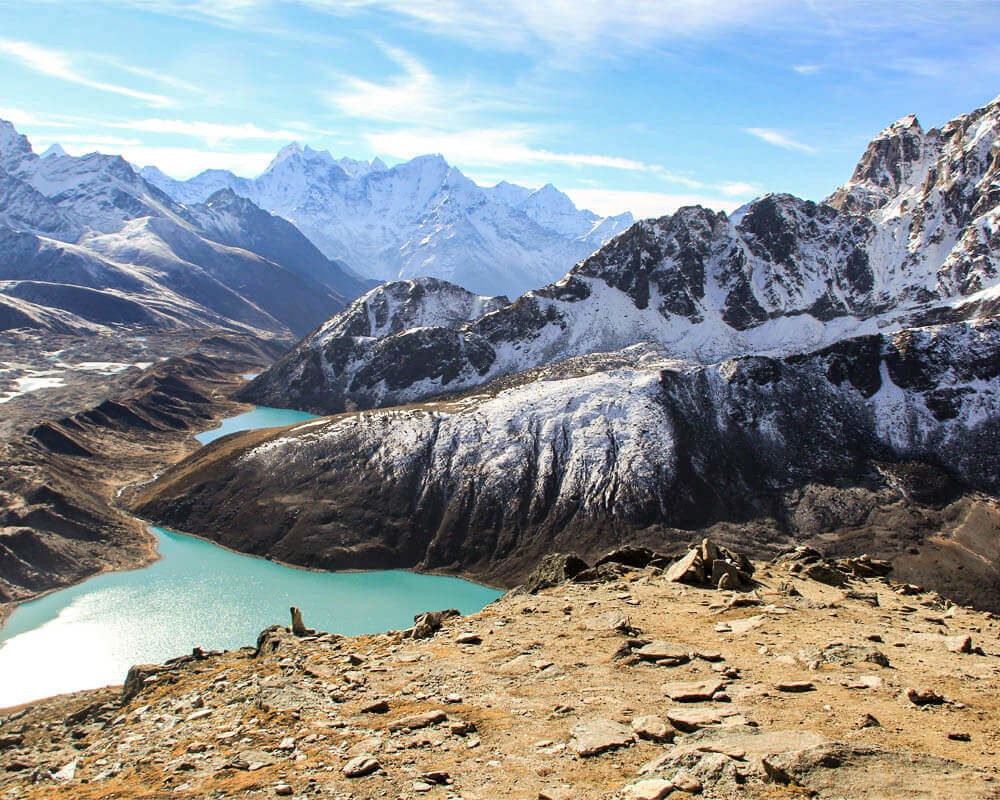 Gokyo Lakes and Mountain views from Gokyo Ri
Gokyo Lakes and Mountain views from Gokyo Ri
The Gokyo Valley trekking itinerary is a few days shorter than the EBC itinerary. It is a 10-day mountain journey in the Everest Region from Kathmandu to Kathmandu. The first three days' schedule stays within the base camp but goes differently on the fourth day. Also, the last two days of Gokyo (9th and 10th) and EBC (11th and 12th) are the same. Hence, you can see details for the 4th to 8th days of the Gokyo Valley Trip below:
4th Day: Trek to Dole (4110m)
Walking time: 6 hours
Today, you start by ascending through Namche Bazaar to the top of the village. Then, you take a right on the flat path for about two and a half hours to Sanasa. From here, you take a left and ascend to Mongla Danda, which may take about an hour and a half.
You hike downwards for half an hour from Mong Hill to Phortse-Tenga and start ascending to Dole through the dense forest of pine and rhododendron trees. You can sometimes see musk deer and Himalayan Monals in this forest and the ice-climbing spots. You walk around 6 hours today to Dole from Namche Bazaar and reach above the tree line.
5th Day: Trek to Machchhermo (4470m)
Walking time: 4 hours
It is a short day walk with open views, and the trail is not challenging. Today, you walked around four hours from Dole to Machchhermo. The day begins with a descending path for a few minutes and then gradually flattens. From here, the easy trail starts on the side of the hill and goes to Luza. After Luza, it is a bit steep for half an hour and then descends for another 15 minutes to Machchhermo.
While walking in this beautiful valley today, you will have fantastic views of Mt. Thamsetku, Khangteka, Taboche, Cholatse, and Cho-Oyu.
6th Day: Trek to Gokyo (4790m)
Walking time: 4 hours
It is also another short day, which takes around four hours. It means you reach Gokyo for lunch. The day starts with ascending the trail and staying on the flat path for an hour, then ascending after a short downhill towards the first lake. You won't have to climb after this tiny lake. The mountain views are mostly the same as the previous day, but you can see three Gokyo Lakes and Brahmin ducks today.
7th Day: Hike to Gokyo Ri (5360m) and Trek back to Dole (4110 m).
Walking time: 7-8 hours
Today, you hike to Gokyo Ri in the early morning, which takes around two hours to reach the top. You can see magnificent Everest Himalayan views in 360° surroundings, including the four highest mountains over 8000 meters (Everest, Lhotse, Makalu, and Cho-Oyu), the biggest glacier (Ngozumba), and tranquil lakes.
After descending from Gokyo Ri, you have breakfast at the lodge and trek back to Dole through Machchhermo, following the same trail.
8th Day: Trek back from Dole to Namche Bazaar (3440 m).
Walking time: 5–6 hours
It is not an unfamiliar trail today, but walking the opposite way can be different. You start walking downward for an hour to Phortse-Tenga and then climb to Mong Danda for about two hours. The trail descends to Kyanjuma and stays flat for the last part of the Namche Bazaar.
The 9th and 10th-day itineraries are the same as those for the Everest Base Camp Trek on the 11th and 12th.
If you want the Gokyo Valley Trek, please get in touch with us or book directly from our package page.
For more information, you can combine these two treks (EBC and Gokyo Valley) in one itinerary, making a loop via Cho La Pass, and either visit EBC or Gokyo first. Trekkers are crossing Cho La from Gokyo and EBC on both sides, so check out the details about the route here:
Everest Base Camp vs. Gokyo: Scenery
Are there similar scenery on the EBC and Gokyo Lakes Treks? They are mostly identical, but there are many different things to see on these routes. Check them out below:
Trek in Different Valleys
The trail to EBC leads through Khumbu Valley and Gokyo Ri through Gokyo Valley, so the trekking trails lead entirely to the different river valleys. You see more mountains while walking on the Khumbu EBC side than on the Gokyo side.
The EBC route has more villages, ancient monasteries, and Buddhist monuments than the Gokyo route. Also, the base camp side is wider than the Gokyo Valley.
Views from Kalapatthar and Gokyo Ri
Kalapatthar offers the nearest view of Mt. Everest, but from here, it does not look like the world's highest mountain because Mt. Everest is so close to you. On the other hand, Gokyo Ri is a bit far from seeing Mt. Everest. However, you can find that it is the tallest in the world. You can only see the two highest mountains above 8000 meters from Kalapatthar, but four from the Gokyo Ri. Both hill stations offer magnificent views of the Everest Himalayas from 360° angles. However, you can see more mountains from Gokyo Ri than from Kalapatthar.
Hiking to Gokyo Ri from the lakeside is steeper than hiking to Kalapatthar, which is more challenging because of its elevation and cold temperature.
About Reaching a Closer Distance to the High Mountains
You can get very close to the high mountains on the EBC Trek but quite far on the Gokyo Lakes Trek. You reach the bottom of Nuptse, Khumbutse, Lola, and other tall peaks when you hike to the EBC, but not on the Gokyo side. Although you can get very close to Mt. Cho-Oyu if you hike to the 5th lake and see the full-shaped Everest,
Glaciers and Lakes
You can see the world's famous Khumbu Glacier and Icefall on the EBC part and Khumbu's biggest glacier, Ngozumba, on the Gokyo side. You can step on Khumbu Glacier but only see Ngozumpa from Gokyo Peak.
You can see tiny lakes along the base camp route far away, but you can touch numerous tranquil lakes on the Gokyo trek.
Difficulties During Everest Base Camp and Gokyo Valley Treks
The EBC Trek feels slightly more complicated than the Gokyo Valley Trek, with long days of walking at high altitudes and temperatures. Everyday trekking distance on the way up and return is longer on the EBC route than the Gokyo Valley.
There is a higher risk of altitude sickness in the Khumbu Valley, although there is one extra acclimatization rest day compared to the Gokyo trek.
In the high trekking falls, the guest houses in Tengboche, Lobuche, and Gorakshep are usually packed, so getting accommodations there might be challenging. Still, more spaces are available in the Gokyo region. The trail to the Gokyo Valley is calmer, with fewer trekkers, compared to the EBC route, which can be crowded and noisy.
Best time for Gokyo and Everest Base Camp Treks
Autumn and Spring are the best times for both treks to see the mountains. On the EBC Trek, you won't come across any lakes. The Gokyo Valley Trek offers a good view of the Everest Himalayas, but the lakes will be frozen during the Spring. So, September to December is the best month to visit Gokyo Lakes.
EBC has many tents for climbers planning to climb Mt. Everest, and in the Spring, the place looks like a mini mountain city. You can meet many Everest climbers this time, and the temperature is warmer than in Autumn. However, the mountains look brighter in Autumn, so if you have time, we suggest trekking from September to December to EBC.
Can't Trek at High Altitudes or Don't Have Enough Time?
If you do not have enough time for a long mountain trek to go to EBC or Gokyo Lakes, you still might have the desire to see the world's most famous mountain and its range at least once in your lifetime. You can still go to Kalapatthar, base camp, and Gokyo Lakes in a luxurious way from Kathmandu.
Helicopter departs daily from Kathmandu Airport to these places in the morning. If you would like to take this luxury helicopter tour, you do not need to charter. We manage a group that you can join to fly with. This scenic helicopter flight is a miraculous mountain trip that can be one of your best tours.
Conclusion
Gokyo Lakes and Everest Base Camp Treks are beautiful trekking destinations in the Everest region. These individual routes have their attractions and vantage points, so you can choose any one or combine the two via the Cho La pass.
The Gokyo Trek can be done in 10 days, and the Everest Base Camp Trek in 12 days. The Gokyo Trek is comparatively more straightforward than the EBC Trek, but you might have the wish to step on the foot of the world's highest mountain at least once in your life. For better views, Gokyo Ri can be one of the best places in the region.
For many years, we have arranged these two treks individually or together. We can arrange the trips if you want to trek on these trails. If you have more questions about Gokyo Lakes and the Everest Base Camp Trek, you can contact us at any time through our contact page.
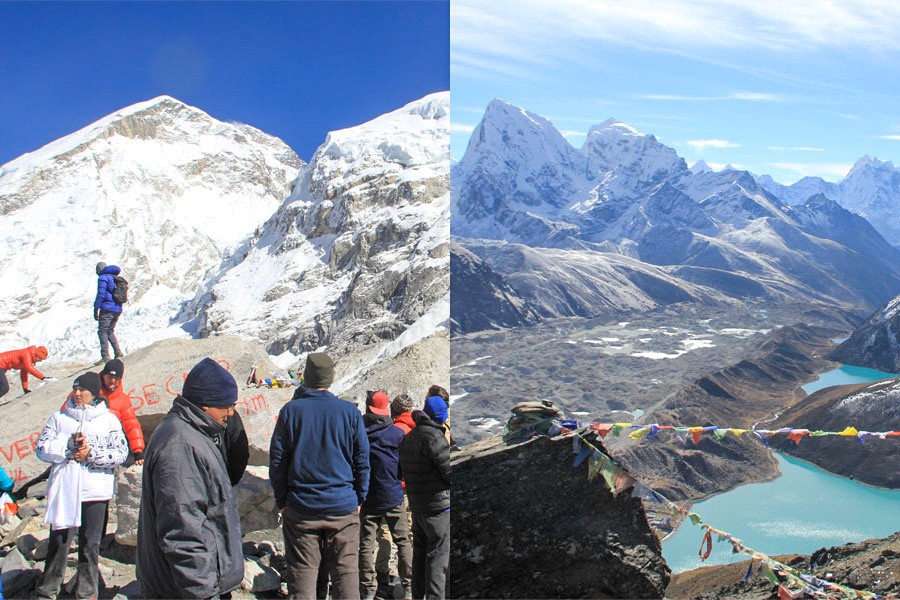
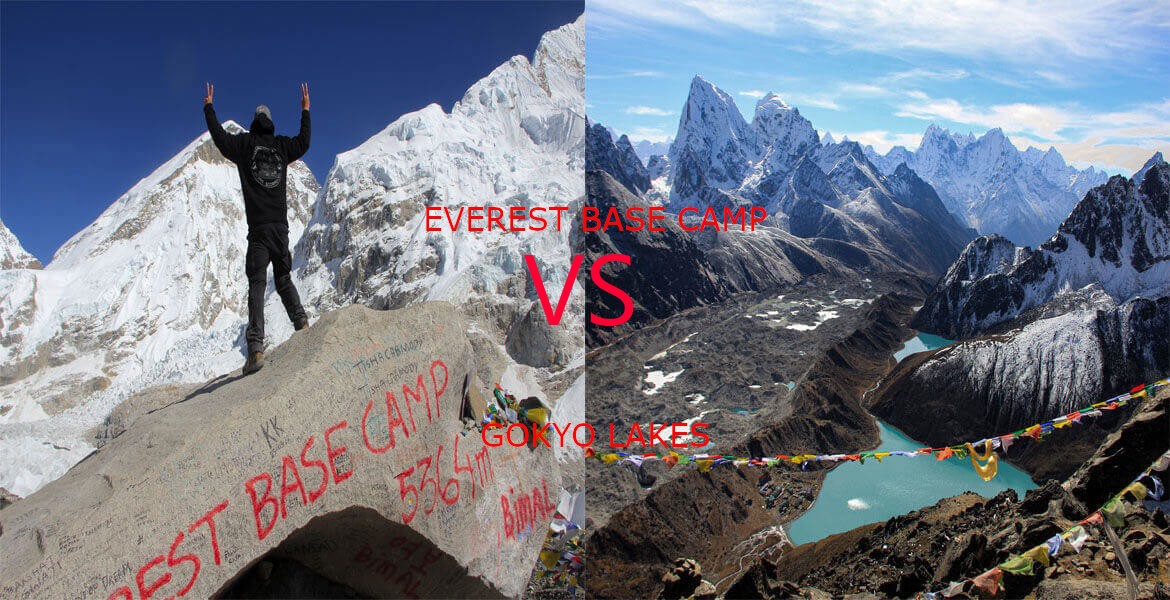
.jpg)

